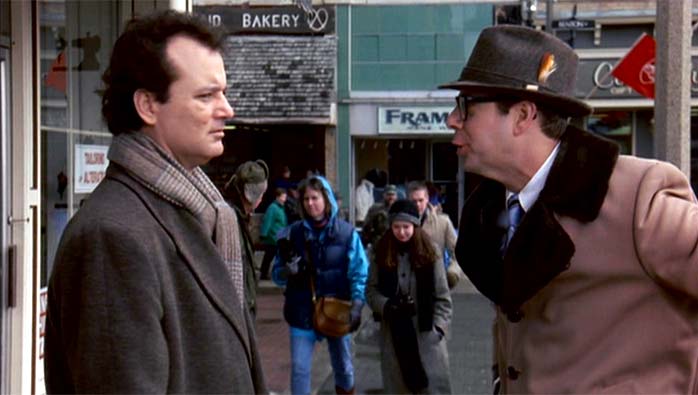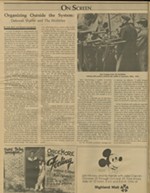
Groundhog Day
1993, PG, 103 min. Directed by Harold Ramis. Starring Bill Murray, Andie MacDowell, Chris Elliott, Stephen Tobolowsky.
REVIEWED By Louis Black, Fri., Feb. 19, 1993
Working within the confines of what could have been an amazingly restricting idea -- that weatherman Bill Murray is trapped in Punxsutawney, Pennsylvania on February 2, forced to live Groundhog Day over and over -- co-writer/director Ramis has instead fashioned a surprisingly romantic comedy. At 6am on February 2, Murray wakes up to Sonny and Cher, and apart from covering the ceremonies and being prevented by a blizzard from returning home, he really doesn't do much. He's cynical, lazy and emotionally distanced, a semi-star and major weatherman in the Pittsburgh market. The next morning as 5:59am switches to 6am, Sonny and Cher come on again and he encounters the same stranger on the stairs, the same proprietor in the dining room, the same old high school classmate on the street. Waiting at the ceremonies, his producer (MacDowell) and cameraman (Elliott) still don't like him. More and more freaked, he goes through the day and awakens the next morning to Sonny and Cher and the whole town heading out to see whether or not Punxsutawney Phil is going to see his shadow. There were a lot of ways for this film to go stupid; it succumbs to none of them. At first, Murray tries to find a way out. He confides in his producer, a doctor, and a psychiatrist -- nobody gets it. Then he begins to use the recurrence to his advantage. Approaching an attractive woman, he finds out her name, high school, and 12th grade teacher. The next day for Murray, which is the same day for everyone else, he pretends to be an old high school friend of hers and uses this opening to seduce her. He begins to pig out as well, eating and drinking and carrying on. Eventually he begins to kill himself. But he's also falling more and more in love with MacDowell and begins to pursue her. At first, he manipulatively goes after her, day after day, fine-tuning his approach. At every junction of his seduction if he fails, he asks her what is wrong and the next day, which to her is still his first attempt, he adapts his approach. Finally, he realizes he wants more than just to sleep with her and he begins to change himself, day after day, which is the same day, Groundhog Day. Although we are trapped in the same day, and the film pretty much respects the logical boundaries, the situations unfold differently (to some extent) and though it's basically the same day over and over, new characters, situations and information are introduced all the time. Ramis wisely unravels his plot, using both variation and repetition to terrific effect, as you know what is coming but not exactly how it is going to happen. It's all believable, in a way. When Murray is first trapped, he tries to get out. Then he figures out what's going on and uses it to his advantage, after which he goes through a period of despair and finally, growth. Within the confines of this repetition, Ramis, Murray and MacDowell work wonders. The best of Ramis' early work as a writer and/or director, including Meatballs, Stripes, the truly bizarre Caddyshack, and Ghostbusters, mixed moments of genuine madcap humor with adolescent frat boy posturing. Sadly perhaps, Groundhog Day represents a mature Ramis, the film is more consistent and perceptive. In Jacques Rivette's 3 1/2-hour masterpiece, Celine and Julie Go Boating, during the last half hour, he does much the same thing. Characters go back to visit situations they previously lived. The Rivette film used this situation as a way to comment on form, on narrative structure, on memory and on film. Ramis uses it as a remarkable metaphor for mundane life, for life without love. In many ways we're all trapped in the same day over and over again and the way out, Ramis suggests, is through ourselves.
A note to readers: Bold and uncensored, The Austin Chronicle has been Austin’s independent news source for over 40 years, expressing the community’s political and environmental concerns and supporting its active cultural scene. Now more than ever, we need your support to continue supplying Austin with independent, free press. If real news is important to you, please consider making a donation of $5, $10 or whatever you can afford, to help keep our journalism on stands.
Marc Savlov, June 26, 2009
Marjorie Baumgarten, Nov. 25, 2005
May 3, 2022
Groundhog Day, Harold Ramis, Bill Murray, Andie MacDowell, Chris Elliott, Stephen Tobolowsky









